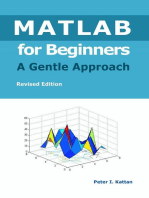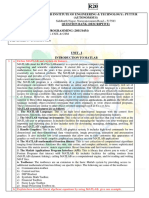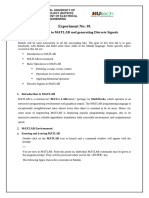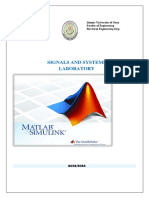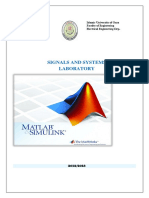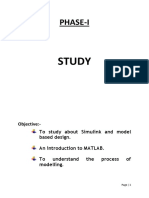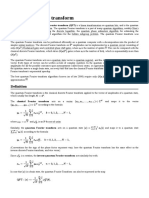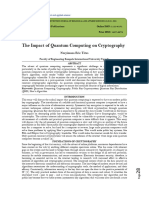4 Teaching Optimization Techniques Using Matlab and Mathematica A Comparative Study
Uploaded by
maherkamel4 Teaching Optimization Techniques Using Matlab and Mathematica A Comparative Study
Uploaded by
maherkamelJournal of Information & Communication Technology
Vol. 6, No. 1, (Spring 2012) 18-26
Teaching Optimization Techniques using Matlab and
Mathematica: A Comparative Study
Ingila Rahim *
Mathematical Sciences Research Center.
Federal Urdu University of Arts, Science and Technology, Karachi, Pakistan.
Muhammad Arif Hussan *
Institute of Business & Technology (IBT), Karachi, Pakistan.
ABSTRACT
This paper aims to explore how technology-based teaching (with Matlab and
Mathematica) helps students in understanding optimization methods. Students
solve linear programming problems using Matlab and Mathematica. Some
examples and case study are used to discuss and explain issues that have been
observed while using technology in completing this course. Results show that
Mathematica linear programming algorithm is better than the algorithm for the
same command in Matlab. Students also learn to counter check important results
of optimization problems at hand. This sort of experimental mathematics helped
students in improving their confidence levels in attacking optimization problems.
INSPEC Classification : C1180, A0140G, A0150H, A0150K
Keywords : Matlab, Mathematica, optimization problem, comparison of Matlab and
Mathematica
1. INTRODUCTION
Computer algebra systems (CAS) are gaining increasing interest in the every day work
of students. The use of these application software help students a lot in understanding the
concepts of physics and mathematics. However, students erroneously assume that CAS
tools always know more than they do about how to compute a mathematical expression.
It is recommended for students to perform calculations in more than one ways in order to
counter check final results of problems at hand (Aguirregabiria JM, Hernandez A, and
Rivas M, 1994).
Research (Hoyles C. & Noss R., 2003), (Kendal M. & Stacey K., 1999) shows that students
learn more from an organized lecture when they are technology-based. Other group says
that (Wicks, R. J., 1999), (Wicks, R. J., 1996) Mathematica and Maple are two such systems
with which we can create rich learning experience for our students. There has been a wide
* The material presented by the authors does not necessarily portray the viewpoint of the editors
and the management of the Institute of Business and Technology (IBT) or Federal Urdu University of Arts,
Science and Technology.
* Muhammad Arif Hussain : wmarif2002@yahoo.com
* Ingila Rahim : Ingila.rahim@gmail.com
C
JICT is published by the Institute of Business and Technology (IBT).
Ibrahim Hydri Road, Korangi Creek, Karachi-75190, Pakistan.
Teaching Optimization Techniques using Matlab and Mathematica: A Comparative Study
range of computer activities (Shaw W T and Tigg J., 1994)(Davis B, Porta H and Uhl J.,
1994) used in teaching mathematical concepts. In order to enhance students' understanding
of abstract linear algebra concepts, the author worked on classroom activities supported
by Matlab and Mathematica to provide inquiry-based learning environments. Mathematica
ahs also powerful graphics capability (Maeder R, 1999).
According to a comparison of the two CAS tools, Mathematica can do all the numeric
math and matrix work that Matlab can do, as fast and as accurately. Many of Mathematica's
functions switch automatically between different algorithms, whereas in Matlab one must
always choose the algorithm. Matlab requires one to manually linearize ordinary differential
equations (ODEs) to a system of first order equations before it can solve them, but
Mathematica accepts any order ODE. Matlab can do integration up to only three dimensions
(with triplequad), but Mathematica handles n-dimensional
(http://www.helium.com/items/895074-comparing-matlab-and-mathematica, 2012).
Other viewpoint is that Mathematica is easier to use. It is better for symbolic and analytic
job, whereas Matlab is good for numeric computations
(http://www.physicsforums.com/showthread.php?t=196740 , 2012).
Section 2 gives some detail of linear programming mathematical formulation. In Section
3, basics commands of Matlab and Mathematica is discussed to attack mathematical
problems. Finally, Section 4 concludes this paper
2. Linear Programming (LP) Formulation
In general, linear programming problems minimize a linear function of real variables over
a region defined by linear constraints (Nash, S. and Sofer, A. 1996).
where x is a vector of n real numbers, and Ax = b is a set of linear equality constraints
and x 0 reveals that all variables are nonnegative. The dual of this problem can be
formulated as
where l is a vector of Lagrange multipliers (Smith K. J. and Bradley G. L., 1999) and s
is a vector of dual slack variables. These two problems are intimately related, and algorithms
typically solve both of them simultaneously. When the vectors x *, l *, and s * satisfy the
following optimality conditions:
then x * solves the primal problem and (l * , s* )solves the dual problem.
In the next section we summarize the basics of Matlab and Mathematica commands which
help to solve linear and nonlinear problems.
Vol. 6, No. 1, (Spring 2012)
19
Ingila Rahim, Muhammad Arif Hussan
3. Matlab and Mathematica Basics
This Section gives basics of popular computer algebra systems (CAS), namely MATLAB
and Mathematica for the specification of numerical as well as symbolic calculations, and
linear programming (LP) commands, which in turn helps in getting solution to a given
optimization problem. These tools generally provide partial functionality of the kind to
be created in many real world projects. We try to illustrate important features of these tools
in LP problem solving. Students are encouraged to develop their own problem solving
skills with CAS tools. In addition, all these computer activities are supposed to be augmented
by classroom lessons where ideas are discussed and applied.
3.1. Some Basic Operations in MATLAB
Addition of numbers in Matlab.
>> 2 + 1/2
ans =
2.5000
This shows use of MATLAB as a calculator. Now, we look at the matrix representation
in two different formats.
>> b=[1,2,3;2,0,9;0,0,3];
>> c=[1 2 3;2 0 9;0 0 3];
>> b'
ans =
1
2
3
2
0
9
0
0
3
>> c'
ans =
1
2
3
2
0
9
0
0
3
The commas in the specification of b can be replaced with spaces, as depicted by matrix
c. Square brackets refer to vectors and parentheses are used to refer to elements within a
matrix. The command det and inv return the determinant and inverse of a matrix
respectively. The ' performs the transpose of a matrix. Transpose of matrices b and c, as
shown above.
The help command returns information on different commands.
3.1.1. Calculus with MATLAB
Differentiation
For constructing symbolic objects, we define
>> syms x
20
% defines x as symbolic variable
Journal of Information & Communication Technology
Teaching Optimization Techniques using Matlab and Mathematica: A Comparative Study
>> y=x*x; diff(y,x)
% diff differentiates y w.r.t. x
ans =
2*x
For its second derivative we write
>> y=x*x;diff(y,x,2)
ans =
2
Integration
MATLAB uses int command to integrate. For example, int(S, x) is the indefinite integral
of S with respect to 'x'. Similarly, int(S, v, a, b) is the definite integral of S with respect
to v from a to b. We demonstrate these with few examples.
>>
>>
syms x t;
int(1/(1+x^2))
ans =
atan(x)
3.1.2. Linear Programming in Matlab
In Matlab LINPROG (or linprog) command is used for Linear programming. The syntax
is as follows (Venkataraman P., 2001).
X=LINPROG(f,A,b) attempts to solve the linear programming problem:
min f'*x
subject to: A*x # b
Another option is:
X=LINPROG(f,A,b,Aeq,beq) solves the problem above while additionally satisfying
the equality constraints Aeq*x = beq.
Similarly, we can use
X=LINPROG(f,A,b,Aeq,beq,LB,UB) defines a set of lower and upper bounds on the
design variables, X, so that the solution is in the range LB# X# UB. Use empty matrices
for LB and UB, if no bounds exist. Set LB(i) = -Inf if X (i) is unbounded below;
set UB(i) = Inf if X (i) is unbounded above.
In addition Matlab has other commands as well for linear and nonlinear programming.
3.1.2.1. Linear Programming Examples
We solve following examples (Hoffmann LD and Bradley GL., 1995), with Matlab
command linprog
Examples:
1) We solve the LP problem:
Maximize P = 1.2 H + L
Vol. 6, No. 1, (Spring 2012)
21
Ingila Rahim, Muhammad Arif Hussan
Subject to: 10 H + 12 L # 1920
5 H + 3 L # 780
H, L # 0
Matlab Input:
>> f=[-1.2,-1];
A=[10,12;5,3];
b=[1920 780];
>> [x,fval]= linprog(f,A,b)
Matlab Output:
Optimization terminated.
x=
120.0000
60.0000
fval =
-204.0000
Minus sign shows that we solveded a problem of Maximization.
2)
We solve the LP problem:
Minimize F = 7 x1+ 20 x2
Subject to:
x1 + 2 x2 $ 2
x1 + 5 x2 $ 3
x1, x2 $ 0
Solution to this problem is: F = 16, x1, = 4/3, x2 = 1/3
3)
We solve the LP problem:
Maximize F = 2x1 + x2 + 3 x3
Subject to:
x1 + 2x2 + x3 # 12
2 x1 + x2 + x3 # 20
x1 + x2 + 2 x3 # 20
x1, x2 , x3 $ 0
Matlab linprog command fails to solve this simple example. The same set of examples
will be solved by Mathematica in the next section.
3.2. Symbolic Computations in Mathematica
[Input]: x + x
[Output]:2x
[Input]: x = 3; y = 5; x + y
[Output]:8
Mathematica has many powerful features which go far beyond even what is needed for
calculus. We define some functions for the purpose of evaluation. The syntax for defining
function is as follows:
g[x_] := x^3 + 5;
h[x_] := -2*x + 3;
22
Journal of Information & Communication Technology
Teaching Optimization Techniques using Matlab and Mathematica: A Comparative Study
Here, we defined two functions g(x) and h(x). It is necessary to use := and the underline
after the variable. It is also important to note that functional dependence in Mathematica
is always denoted by square brackets [ ].
[Input]:
[Output]:
g[2]
13
Similarly,
[Input]: h[2]
[Output]: -1
Sign ? (or ??, for more detail) can be used to get help on any command. For instance, to
get help on FindRoot command in Mathematica do the following.
[Input]: ?FindRoot
[Output]: FindRoot[lhs==rhs, {x, x0}] searches for a numerical solution to the
equation lhs==rhs. Similarly, FindRoot[{eqn1, eqn2, }, {{x, x0},{y, y0},}] searches
for a numerical solution to the simultaneous equations eqni.
3.2.1. Calculus in Mathematica
Differentiation
The derivative g'(x) can be obtained by using command: D[ ] as given below.
[Input]: D[g[x],x]
[Output]:3x2
Integration
We define another function f(x):
f[x_] := 1 / (x + 5);
Now, we perform integration in Mathematica environment.
[Input]: Integrate[f[x],x]
[Output]:Log[x+5]
The above result is exact. One can also obtain numerical integration of the same function
as follows.
[Input]: NIntegrate[f[x], {x,2,4}]
[Output]:0.251314
3.2.2. Linear Programming in Mathematica
In Mathematica, there are several ways to solve Linear Programming problems. One
command which is based matrix formulation is given below (Wolfram Research, Inc.,
2003).
LinearProgramming[c, m, b]. This command finds vector x which minimizes cx.
Subject to the constraints mx $ b and x $ 0
Similarly, one can use
LinearProgramming[c, m, b, l]. This command finds vector x which minimizes cx.
Subject to the constraints mx$ b and x $ l
Vol. 6, No. 1, (Spring 2012)
23
Ingila Rahim, Muhammad Arif Hussan
Mathematica also has other commands Minimize, Maximize, NMinimize, and NMaximize
for the solution of linear and nonlinear optimization problems. Maximize and Minimize
commands give exact (or symbolic) solutions to the problems, whereas NMinimize, and
NMaximize commands show numeric solutions to the problems.
3.2.2.2. Examples
Here, we solve the same set of examples as given in Section 3.12.1.
1) We solve the LP problem:
Maximize P = 1.2 H + L
Subject to: 10 H + 12 L # 1920
5 H + 3 L # 780
H, L $ 0
LinearProgramming[{-1.2 ,-1},{{-10,-12},{-5,-3}},{-1920,-780}]
Answer: P = 204, H = 120, L = 60.
2) We solve the LP problem:
Minimize F = 7 x1+ 20 x2
Subject to:
x1 + 2 x2 $ 2
x1 + 5 x2 $ 3
x1, x2 $ 0
Answer: F = 16, x1 = 4/3, x2 = 1/3.
3)We solve the LP problem:
Maximize F = 2 x1 + x2 + 3 x3
Subject to:
x1 + 2x2 + x3# 12
2 x1 + x2 + x3# 20
x1 + x2 + 2 x3# 20
x1, x2 , x3# 0
Matlab was unable to solve this problem as we observed in the previous section. We solving
this LP problem with Mathematica by two different commands.
Mathematica Solution:
We use the first command LinearProgramming[ ]
1) LinearProgramming[{-2,-1,-3},{{-1,-2,-1},{-2,-1,-1},{-1,-1,-2}},{-12,-20,-20}]
Output: {4, 0, 8}
Maximum F comes out to be 32. at x1= 4, x2 = 0, and x3 = 8
And now we use another command Maximize[ ]
2) Maximize[{2a+b+3 c,a+2 b+ c# 12,2 a+ b+ c# 20,a+ b+2 c# 20,a$ 0,b$ 0,c$ 0},{a,b,c}]
Here, a = x1 b = x2 , c = x3 .
Output is:
F = 32, a6 4, b6 0, c6 8
.Above answer is same as given in the reference text. Next we solve a case study with
Matlab and Mahematica.
3.2.2.3. Case Study
Forest Service Allocation: The US forest services has used just such an allocation model
to address the sensitive task of managing 191 million acres of national fresh land (Rardin
R L.,1998). The forest service must tradeoff timber, grazing, recreational, environmental,
24
Journal of Information & Communication Technology
Teaching Optimization Techniques using Matlab and Mathematica: A Comparative Study
national preservation, and other demands on forestland. For this purpose it defines a linear
programming model in order to maximize total net present value (NPV) per acre of all
uses in area. Twenty one variables (all positive) are defined.
The above problem is solved with Matlab and Mathematica. Results are more or less
similar to the published report from the two CAS tools. However, Mathematica result sems
to be better, as it is closer to the reported NPV in the report.
a) MATLAB Solution: Box 1: Malab linprog command to solve the case study.
Box 1 gives the solution of the above cases tudy. Now, we perform calculation with
Mathematica.
As Maximize command in Mathematica can accommodate all types of constraints found
in the literature therefore, we solve this case study with Maximize command .
b) Mathematica Solution:
Box 2. Mathematica notebook showing Mathematica command for Maximization.
Vol. 6, No. 1, (Spring 2012)
25
Ingila Rahim, Muhammad Arif Hussan
Box 2 gives the input and output of the case study pergormed with Mathematica.
4. Conclusion and Future Outlook
We demonstrated three simple examples of optimization problems and a case study to
guide students using Matlab and Mathematica optimization commands and helped them
in technology-based learning environments. Comparison of Matlab and Mathematica
reveals that Mathematica is better for exact and analytical calculations, whereas Matlab
is faster for numeric calculations. Reported case study is the result of ongoing research
investigating the effect of technology on teaching and learning optimization techniques.
Results revealed that Mathematica linear programming algorithm wss better than the
algorithm for the same command in Matlab In fact many factors influence the implementation
of technology in imparting such know how to students. Finally, we can say that Matlab
and Mathematica can be used to improve the students' understanding of optimization
techniques course as well as to counter check important results of problems at hand. These
application softwares help imparting knowledge to students in a shorter time frame. Further
discussion on graphical method of solving optimization problems will be the topic of a
future paper.
5. References
Aguirregabiria JM, Hernandez A, and Rivas M, 1994,"Are we careful enough when using
computer algebra system", Computers in Physics, 8 (1)
Hoyles C. & Noss R., 2003, 'What can digital technologies take from and bring to research
in mathematics education? In: A.J. Bishop, M.A. Clements, C. Keitel, J. Kilpatrick &
F. Leung (Eds.)', Second International Handbook of Mathematics Education (Vol. 1,
pp. 323-349). Dordrecht: Kluwer Academic Publishers.
Kendal M. & Stacey K., 1999, Varieties of teacher privileging for teaching calculus
with computer algebra systems, International Journal of Computer Algebra in
Mathematics Education 6, 233-247.
Wicks, R. J., 1999, Mathematica materials from MAA mini-course on creating
interactive texts in Mathematica. MAA 1999 Joint meetings.
Wicks, R. J., 1996, Linear Algebra: an interactive laboratory approach with
Mathematica. Addison-Wesley Publishing Company, Reading, Massachusetts.
Shaw W T and Tigg J., 1994, "Applied Mathematica: Getting Started, Getting It
Done", Addison-Wesley, Massachusetts..
Davis B, Porta H and Uhl J., 1994, "Calculus andd Mathematica:, Addison-Wesley,
Massachusetts..
Maeder R, 1999, "Programming in Mathematica", Addison-Wesley, Massachusetts.
http://www.helium.com/items/895074-comparing-matlab-and-mathematica, 2012.
http://www.physicsforums.com/showthread.php?t=196740 , 2012.
Nash, S. and Sofer, A. 1996. Linear and Nonlinear Programming. McGraw-Hill. Smith
K. J. and Bradley G. L., 1999, "A Mathematica:Approach To Calculs 2/e",
Addison-Wesley, Massachusetts..
Venkataraman P., 2001, 'Applied Optimization with Matlab Programming', Wiley.
Hoffmann LD and Bradley GL, 1995, 'Finite Mathematics with Calculus', McGraw-Hill,
NY., pp. 153-204.
Wolfram Research, Inc. 2003 , Mathematica, Version 5.0, Champaign, IL.
Rardin R L, 1998, "Optimization in Operations Research", Prentice-Hall, NJ, pp.
132-134..
26
Journal of Information & Communication Technology
You might also like
- 100 Data Science Interview Questions and AnswersNo ratings yet100 Data Science Interview Questions and Answers33 pages
- Matlab: Comm2M Harry R. Erwin, PHD University of SunderlandNo ratings yetMatlab: Comm2M Harry R. Erwin, PHD University of Sunderland45 pages
- Ch01 - Introduction To MATLAB+Ch02 - MATLAB Basics (Part 1)No ratings yetCh01 - Introduction To MATLAB+Ch02 - MATLAB Basics (Part 1)66 pages
- Department of Electrical Engineering Communication Systems: LAB-1 Introduction To MatlabNo ratings yetDepartment of Electrical Engineering Communication Systems: LAB-1 Introduction To Matlab5 pages
- Introduction To MATLAB: Yunkai Liu Assistant Professor Computer Science Department University of South DakotaNo ratings yetIntroduction To MATLAB: Yunkai Liu Assistant Professor Computer Science Department University of South Dakota36 pages
- Computational Lab Materials Basics MATLAB Class 1No ratings yetComputational Lab Materials Basics MATLAB Class 115 pages
- Lab 1 Introduction To Matlab:: ObjectivesNo ratings yetLab 1 Introduction To Matlab:: Objectives9 pages
- MATLAB: How Do You Work With Data To Solve Problems?No ratings yetMATLAB: How Do You Work With Data To Solve Problems?75 pages
- Foundations of Engineering With MATLAB 7: Eric S. CarlsonNo ratings yetFoundations of Engineering With MATLAB 7: Eric S. Carlson14 pages
- Lab Work File: 5 Semester ECE (2017 Batch)No ratings yetLab Work File: 5 Semester ECE (2017 Batch)24 pages
- Numerical Methods in Engineering With MATLAB - 2005 (2) - 10-36 PDFNo ratings yetNumerical Methods in Engineering With MATLAB - 2005 (2) - 10-36 PDF27 pages
- Internship Report: Navya Srivastava 1900520310040 Semester: 5thNo ratings yetInternship Report: Navya Srivastava 1900520310040 Semester: 5th24 pages
- Numerical Methods For Civil Engineers (MATLAB)No ratings yetNumerical Methods For Civil Engineers (MATLAB)221 pages
- Basic Simulation Lab File (Es-204) : Ravi Kumar A45615820008 B.Tech Ce 4 SEMNo ratings yetBasic Simulation Lab File (Es-204) : Ravi Kumar A45615820008 B.Tech Ce 4 SEM49 pages
- Inspection, Quality Control, and Assurance SHEET (1) : 6-If The Mean Value of The Measured Stress Was 15 KG/MMNo ratings yetInspection, Quality Control, and Assurance SHEET (1) : 6-If The Mean Value of The Measured Stress Was 15 KG/MM1 page
- Beyond Taguchi's Concept of The Quality Loss Function: Atul Dev, Pankaj JhaNo ratings yetBeyond Taguchi's Concept of The Quality Loss Function: Atul Dev, Pankaj Jha5 pages
- The Quality Improvement Model: Is Process Capable?No ratings yetThe Quality Improvement Model: Is Process Capable?19 pages
- Attributes Data: Binomial and Poisson DataNo ratings yetAttributes Data: Binomial and Poisson Data31 pages
- PyQUBO Python Library For Mapping Combinatorial OpNo ratings yetPyQUBO Python Library For Mapping Combinatorial Op13 pages
- Maximizing The Efficiency Using Montgomery Multipliers On FPGA in RSA Cryptography For Wireless Sensor NetworksNo ratings yetMaximizing The Efficiency Using Montgomery Multipliers On FPGA in RSA Cryptography For Wireless Sensor Networks14 pages
- Download full (Ebook) Absolute Risk: Methods and Applications in Clinical Management and Public Health by Ruth M. Pfeiffer, Mitchell H. Gail ISBN 9781466561656, 1466561653 ebook all chapters100% (9)Download full (Ebook) Absolute Risk: Methods and Applications in Clinical Management and Public Health by Ruth M. Pfeiffer, Mitchell H. Gail ISBN 9781466561656, 1466561653 ebook all chapters55 pages
- A Flower Recognition System Based On Image Processing and Neutral NetworkNo ratings yetA Flower Recognition System Based On Image Processing and Neutral Network8 pages
- Homework 2 Solutions: G (0) 1 and G (1) 1/2. Therefore G (X) Is in (0,1) For All X in (0,1) - and Since G IsNo ratings yetHomework 2 Solutions: G (0) 1 and G (1) 1/2. Therefore G (X) Is in (0,1) For All X in (0,1) - and Since G Is6 pages
- Sharpe Index Model: Portfolio Expected Return E (R) oNo ratings yetSharpe Index Model: Portfolio Expected Return E (R) o2 pages
- CONFIDENCE INTERVAL CALCULATOR (Last Updated 1 February 2011)No ratings yetCONFIDENCE INTERVAL CALCULATOR (Last Updated 1 February 2011)11 pages
- ICSE Class 8 Maths Selina Solutions Chapter 15 Linear InequationsNo ratings yetICSE Class 8 Maths Selina Solutions Chapter 15 Linear Inequations5 pages
- (Ebook) Econometric Analysis of Panel Data (Springer Texts in Business and Economics) by Badi H. Baltagi ISBN 9783030539528, 9783030539535, 3030539520, 3030539539 - Own the ebook now with all fully detailed content100% (2)(Ebook) Econometric Analysis of Panel Data (Springer Texts in Business and Economics) by Badi H. Baltagi ISBN 9783030539528, 9783030539535, 3030539520, 3030539539 - Own the ebook now with all fully detailed content69 pages
- 50 Most Important CNN Interview QuestionsNo ratings yet50 Most Important CNN Interview Questions18 pages
- The Impact of Quantum Computing On Cryptography (WWW - Kiu.ac - Ug)No ratings yetThe Impact of Quantum Computing On Cryptography (WWW - Kiu.ac - Ug)4 pages
- Matlab: Comm2M Harry R. Erwin, PHD University of SunderlandMatlab: Comm2M Harry R. Erwin, PHD University of Sunderland
- MATLAB for Beginners: A Gentle Approach - Revised EditionFrom EverandMATLAB for Beginners: A Gentle Approach - Revised Edition
- Ch01 - Introduction To MATLAB+Ch02 - MATLAB Basics (Part 1)Ch01 - Introduction To MATLAB+Ch02 - MATLAB Basics (Part 1)
- Department of Electrical Engineering Communication Systems: LAB-1 Introduction To MatlabDepartment of Electrical Engineering Communication Systems: LAB-1 Introduction To Matlab
- Introduction To MATLAB: Yunkai Liu Assistant Professor Computer Science Department University of South DakotaIntroduction To MATLAB: Yunkai Liu Assistant Professor Computer Science Department University of South Dakota
- MATLAB: How Do You Work With Data To Solve Problems?MATLAB: How Do You Work With Data To Solve Problems?
- Foundations of Engineering With MATLAB 7: Eric S. CarlsonFoundations of Engineering With MATLAB 7: Eric S. Carlson
- Numerical Methods in Engineering With MATLAB - 2005 (2) - 10-36 PDFNumerical Methods in Engineering With MATLAB - 2005 (2) - 10-36 PDF
- Internship Report: Navya Srivastava 1900520310040 Semester: 5thInternship Report: Navya Srivastava 1900520310040 Semester: 5th
- Basic Simulation Lab File (Es-204) : Ravi Kumar A45615820008 B.Tech Ce 4 SEMBasic Simulation Lab File (Es-204) : Ravi Kumar A45615820008 B.Tech Ce 4 SEM
- MATLAB for Beginners: A Gentle Approach - Revised EditionFrom EverandMATLAB for Beginners: A Gentle Approach - Revised Edition
- Inspection, Quality Control, and Assurance SHEET (1) : 6-If The Mean Value of The Measured Stress Was 15 KG/MMInspection, Quality Control, and Assurance SHEET (1) : 6-If The Mean Value of The Measured Stress Was 15 KG/MM
- Beyond Taguchi's Concept of The Quality Loss Function: Atul Dev, Pankaj JhaBeyond Taguchi's Concept of The Quality Loss Function: Atul Dev, Pankaj Jha
- The Quality Improvement Model: Is Process Capable?The Quality Improvement Model: Is Process Capable?
- PyQUBO Python Library For Mapping Combinatorial OpPyQUBO Python Library For Mapping Combinatorial Op
- Maximizing The Efficiency Using Montgomery Multipliers On FPGA in RSA Cryptography For Wireless Sensor NetworksMaximizing The Efficiency Using Montgomery Multipliers On FPGA in RSA Cryptography For Wireless Sensor Networks
- Download full (Ebook) Absolute Risk: Methods and Applications in Clinical Management and Public Health by Ruth M. Pfeiffer, Mitchell H. Gail ISBN 9781466561656, 1466561653 ebook all chaptersDownload full (Ebook) Absolute Risk: Methods and Applications in Clinical Management and Public Health by Ruth M. Pfeiffer, Mitchell H. Gail ISBN 9781466561656, 1466561653 ebook all chapters
- A Flower Recognition System Based On Image Processing and Neutral NetworkA Flower Recognition System Based On Image Processing and Neutral Network
- Homework 2 Solutions: G (0) 1 and G (1) 1/2. Therefore G (X) Is in (0,1) For All X in (0,1) - and Since G IsHomework 2 Solutions: G (0) 1 and G (1) 1/2. Therefore G (X) Is in (0,1) For All X in (0,1) - and Since G Is
- Sharpe Index Model: Portfolio Expected Return E (R) oSharpe Index Model: Portfolio Expected Return E (R) o
- CONFIDENCE INTERVAL CALCULATOR (Last Updated 1 February 2011)CONFIDENCE INTERVAL CALCULATOR (Last Updated 1 February 2011)
- ICSE Class 8 Maths Selina Solutions Chapter 15 Linear InequationsICSE Class 8 Maths Selina Solutions Chapter 15 Linear Inequations
- (Ebook) Econometric Analysis of Panel Data (Springer Texts in Business and Economics) by Badi H. Baltagi ISBN 9783030539528, 9783030539535, 3030539520, 3030539539 - Own the ebook now with all fully detailed content(Ebook) Econometric Analysis of Panel Data (Springer Texts in Business and Economics) by Badi H. Baltagi ISBN 9783030539528, 9783030539535, 3030539520, 3030539539 - Own the ebook now with all fully detailed content
- The Impact of Quantum Computing On Cryptography (WWW - Kiu.ac - Ug)The Impact of Quantum Computing On Cryptography (WWW - Kiu.ac - Ug)













